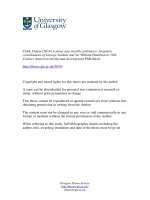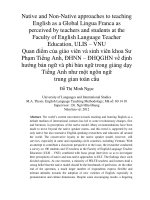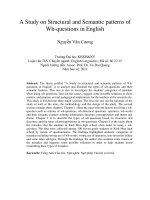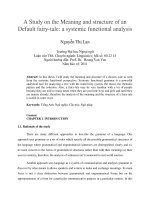topic title: hydrilla verticillata, a submerged aquatic plant, as phytoremediation agent of lead (ii)nitrate (pb(no3)2)
Bạn đang xem bản rút gọn của tài liệu. Xem và tải ngay bản đầy đủ của tài liệu tại đây (1.97 MB, 59 trang )
THAI NGUYEN UNIVERSITY
UNIVERSITY OF AGRICULTURE AND FORESTRY
NGUYEN THI THAO
TOPIC TITLE: HYDRILLA VERTICILLATA, A SUBMERGED AQUATIC
PLANT, AS PHYTOREMEDIATION AGENT OF LEAD (II)-NITRATE
(PB(NO3)2)
BACHELOR THESIS
Study Mode : Full-time
Major
: Environmental Science and Management
Faculty
: International Training and Development Center
Batch
: 2011-2015
Thai Nguyen, 2015
DOCUMENTATION PAGE WITH ABSTRACT
Thai Nguyen University of Agriculture and Forestry
Degree Program :
Bachelor of Environmental Science and Management
Student name :
Nguyen Thi Thao
Student ID :
DTN 1153110148
Thesis Title :
HYDRILLA VERTICILLATA, A SUBMERGED AQUATIC
PLANT, AS PHYTOREMEDIATION AGENT OF LEAD (II)NITRATE (PB(NO3)2)
Supervisor (s):
Dr. Arinafril
Dr. Ho Ngoc Son
Abstract: The experiment of this study were started from March 2015 and finished in
June 2015 at Integrated Research Laboratory of Sriwijaya University Palembang in
Indonesia, with 4 applied treatments (B1: Pb(NO3)2 0 ppm(control), B2: Pb(NO3)2 5
ppm, B3: Pb(NO3)2 10 ppm and B4: Pb(NO3)2 15 ppm) and 3 replications for each
treatment through 5 times of observing in 20 days. Given results were totally evidenced
strong capacity of hydrilla verticillata in absorbing and accumulating heavy metals,
especially lead (Pb) which is known as a dangerous toxicity for living organisms. This
ability of hydrilla verticillata pulled it up to become an effective instrument for
phytoremediation technique in solving environmental issues.
In the research phytoremediation was presented by the use of a submerged aquatic
plant, hydrilla verticillata as a tool of removing Lead (II)-nitrate (Pb(NO3)2) from
water. The revealed results after experiment of 4 treatments, 3 replications in 5 times of
observing shown that hydrilla verticillata is an useful plant for treating Pb contaminant
in water by taking up and storing the metal in its body. After applying Pb(NO3)2 with 4
different treatments, Pb was directly affected hydrilla verticillata morphology based
on higher level of contaminant with the changes in 5 morphological states in order of
normal; leaves became yellow; leaves became faintly yellow; partial decolourization,
complete decolourization and plant died through 20 days of experiment.
Hydrilla verticillata also demonstrated a large percentage of average Pb absorbed
ability is 92.8 % and high ratio of Pb content concentrating in the plant compared to Pb
i
content in water is 1.88. The study also gave predictions of Hydrilla verticillata
potential in improving water quality, with Pb concentration in water was forecasted to
be removed all from water in treatment B1, B2 and B3. Hence, this ability of Hydrilla
verticillata would be widely known and used for water assessing, monitoring and
cleaning operations in the future.
Keywords:
Phytoremediation, Hydrilla verticillata, Lead (II)-nitrate
(Pb(NO3)2), absorbed capacity, water heavy metal pollution.
Number of Pages:
51
Date of Submission:
30/09/2015
Supervisor (Sign)
ii
ACKNOWLEDGEMENT
First and foremost I offer my sincerest gratitude to my supervisor, Dr.-phil.
Arinafril of Sriwijaya University, Indralaya, Indonesia, who has supported and
instructed me throughout my research time and also my thesis completion with all of
his patience, devotions, enthusiasms and empathy. If I have not had his helps I would
have never finished this study.
Also, I would like to show my great appreciation to Dr. Ho Ngoc Son, for
supervising, guiding, counseling and advising me in writing and completing the study.
Besides my two supervisors, I want to send my sincere thanks to the Integrated
Research Laboratory of Sriwijaya University Palembang and the Research laboratory
in the Department of Chemistry, Faculty of Science, Sriwijaya University Indralaya in
Indonesia with their approvals, supports and helps in using place and equipment in the
research time this study is completed successfully.
From the bottom of my heart, I am grateful to Fadila Mutmainnah, S.Si, for her
guidance, support and encouragement during the time of accomplishing this research
in Indonesia.
My special thanks go to Ha, also, Chi, Linh, Marisa, Eka and all my
classmates, friends who helped me in my 3 months of internship time.
Finally, I would like to express my heartfelt gratitude to my parents and
teachers for having, nurturing and teaching me from the very first steps of my life until
now, and their dedications will be my indications for future life.
Thai Nguyen, 30th September 2015
Student
Nguyen Thi Thao
iii
TABLE OF CONTENTS
List of figures.................................................................................................................. 1
List of tables ................................................................................................................... 2
PART I. INTRODUCTION ........................................................................................... 4
1.1. Research rationale..................................................................................................................... 4
1.2. Research’s objectives............................................................................................................... 6
1.3. Research questions and hypotheses ..................................................................................... 6
1.4. Limitations .................................................................................................................................. 7
1.5. Definitions .................................................................................................................................. 7
PART II. LITERATURE REVIEW .............................................................................. 9
2.1. Water environment ................................................................................................................... 9
2.1.1. The importance of water ..................................................................................................... 9
2.1.2. Water resources ..................................................................................................................... 9
2.2. Heavy metal-polluted water ................................................................................................. 10
2.2.1. Source of heavy metal contaminants in water ............................................................. 10
2.2.2. Consequences of heavy metal contaminants in water. .............................................. 11
2.3. Lead Compound- Lead (II) Nitrate .................................................................................... 11
2.4. Phytoremediation .................................................................................................................... 12
2.5. Hydrilla verticillata ................................................................................................................ 13
PART III. METHODS .................................................................................................. 16
3.1. Sampling site and time .......................................................................................................... 16
3.2. Materials and equipment ....................................................................................................... 18
3.3. Methods ..................................................................................................................................... 19
3.3.1. Applying treatments ........................................................................................................... 19
3.3.2. Laboratory method of analyzing Pb content in Hydrilla verticillata .................... 20
3.3.3. Laboratory method of analyzing Pb content in water ............................................... 21
3.4. Data analysis methods ........................................................................................................... 21
3.4.1. Variant analysis ................................................................................................................... 21
3.4.2. Lead (Pb) Reduction rate .................................................................................................. 21
3.4.3. Time Series analysis: Linear regression ........................................................................ 22
3.4.4. Bio-Accumulation Factor .................................................................................................. 22
PART IV. RESULTS ................................................................................................... 23
4.1. Pb concentration in Hydrilla verticillata ........................................................................... 23
4.2. Pb concentration in water ..................................................................................................... 25
4.3. Result of Data analysis .......................................................................................................... 27
4.3.1. Variant analysis ................................................................................................................... 27
4.3.2 Time series analysis: Linear regression.......................................................................... 32
4.3.3. Lead (Pb) reduction rate .................................................................................................... 37
4.3.4. Bio-Accumulation Factor .................................................................................................. 37
4.5. Hydrilla verticillata morphological changes ................................................................... 38
PART V. DISCUSSION AND CONCLUSION .......................................................... 39
5.1. Discussion ................................................................................................................................. 39
5.2. Conclusions .............................................................................................................................. 43
REFERENCES ............................................................................................................. 45
List of figures
Figure 3.1: Jakabaring lake in Palembang, Indonesia. 3’0158.5’S and 104’7965.4’N......16
Figure 3.2: Integrated Research Laboratory of Sriwijaya University, Palembang,
Indonesia which is located in 2’9910.5’S and 104’7295.5’N .......................................17
Figure 4.1: Pb concentration in Hydrilla verticillata .................................................... 24
Figure 4.2: Pb concentration in water............................................................................27
Figure 4.3: Forecasting of Pb concentration in water in treatment B3 .........................33
Figure 4.4: Forecasting of Pb concentration in water in treatment B4 .........................33
Figure 4.5: Forecasting of Pb concentration in Hydrilla verticillata in treatment B1 ..34
Figure 4.6: Forecasting of Pb concentration in Hydrilla verticillata in treatment B2 ...35
Figure 4.7: Forecasting of Pb concentration in Hydrilla verticillata in treatment B3 ...35
Figure 4.8: Forecasting of Pb concentration in Hydrilla verticillata in treatment B4 ...36
1
List of tables
Table 3.1: Experimental design .....................................................................................19
Table 4.1: Pb concentration in Hydrilla verticillata (ppm) .......................................... 23
Table 4.2: Pb concentration in water (ppm) ..................................................................25
Table 4. 3: Significantly different effects of treatments on water’s Pb concentration in
the 5th day .....................................................................................................................28
Table 4. 4: Significantly different effects of treatments on water’s Pb concentration in
the 10th day ...................................................................................................................28
Table 4. 5: Significantly different effects of treatments on water’s Pb concentration in
the 15th day ...................................................................................................................29
Table 4. 6: Significantly different effects of treatments on water’s Pb concentration in
the 20th day ...................................................................................................................29
Table 4. 7: Significantly different effects of treatments on Pb concentration in Hydrilla
verticillata in the 0th day ...............................................................................................30
Table 4. 8: Significantly different effects of treatments on Pb concentration in Hydrilla
verticillata in the 5th day ...............................................................................................30
Table 4. 9: Significantly different effects of treatments on Pb concentration in Hydrilla
verticillata in the 10th day .............................................................................................31
Table 4. 10: Significantly different effects of treatments on Pb concentration in
Hydrilla verticillata in the 15th day ...............................................................................31
Table 4. 11: Significantly different effects of treatments on Pb concentration in
Hydrilla verticillata in the 20th day ...............................................................................32
Table 4. 12: Lead (Pb) reduction rate ............................................................................37
2
Table 4. 13: Bio-Accmulation Factor (BAF) ratio of Lead (Pb) from water to Hydrilla
verticillata ......................................................................................................................37
Table 4. 14: Hydrilla verticillata’s morphological changes observed in different
treatments through time .................................................................................................38
3
PART I. INTRODUCTION
1.1. Research rationale
Playing vital role as a source of life, water have been being an indispensable
resource to humankind and also other organisms. However, water are now getting in a
strong alarmed level of pollution, which can directly impact to the whole planet,
Balkis (2012) stated “Water pollution has been suggested that it is the leading
worldwide cause of deaths and diseases, and that it accounts for the deaths of more
than 14,000 people daily. In addition to the acute problems of water pollution in
developing countries, industrialized countries continue to struggle with pollution
problems as well”. Especially, current time, water is seriously polluted by heavy
metals in the nearby industrial or populated urban areas, these heavy metals can widely
distribute in water and directly or indirectly affect human and living aquatic organisms
due to human activities ( Mohiuddin, et al., 2010).
Lead (II) nitrate (Pb(NO3)2 ) is a toxic compound, and ingestion may cause
acute lead poisoning, and also for all soluble lead compounds (USCG, 1999). Besides,
when dissolve in water, Lead (Pb) from Lead (II) nitrate (Pb(NO3)2, one of the harmful
chemical elements, can be huge influences for human health such as behavioral
problems, high blood pressure, kidney damage, memory and learning difficulties,
reduced IQ, … (Ernhart, 2006; Spivey, 2007). In term of aquatic systems, lead (Pb)
has last and long effects on plants and animals by spreading and existing for long time
of about 100 to 1,000 years in water (UNEP, 2010).
There are many projects and researches had done in treating metal water
pollution, but almost all of those projects required high techniques and also high cost
for the steps and treatment processes. Furthermore, with the variety in kind of metal
4
contaminants, water pollution could not be treated in some sensitive areas and by
former ways (Hogan, 2014).
Phytoremediation, a green technique of treating heavy metal contaminants in
water, uses plants to remove pollutants from the environment. In order to remove
pollutants from water, plants are used to accumulate the heavy metals in contaminated
water, this way of dealing with water pollution shows itself as a friendly and costeffective method for resolving environmental issues (Salt, et al., 1995). With the
ability of absorbing variety kind of metals, and also the real effectiveness for socioeconomics and ecosystems, phytoremediation has been becoming a new favor to use in
removing environmental pollutants (Paz-alberto & Sigua, 2012).
There are many absorbents have been used for removing Lead from water;
water hyacinth (Okunowo & Ogunkanm, 2010), Orange Barks (Azouaou, 2013) or
dried Lemna perpusilla Torr (Tang, et al., 2013). However, unlike those absorbents,
with the very good advantage of living under water, hydrilla verticillata- a submerged
aquatic has its whole body inside water and can grow up to reach the surface which
would has higher potential for environmental science in applying of phytoremediation
as Denny & Wilkins (1987) detected that in the purposes of removing contaminants
from water “whole plant plays important roles the submergence and simplicity of
shoot structure aquatic plants tend to have better potential in heavy metal uptake than
other different structure plants” . Hence, to effectively solve the problems of heavy
metal pollutants in water, this study with the topic is “Hydrilla verticillata, a
submerged aquatic plant, as phytoremediation agent of Lead (II)-Nitrate (Pb(NO3)2)”
was carefully conducted and completed.
5
1.2. Research’s objectives
1. To understand how the submerged aquatic plant - Hydrilla verticillata works as a
tool of phytoremediation and how it got effect from Lead (II)-nitrate (Pb(NO3)2)
polluted water.
2. To assess the ability of Hydrilla verticillata in removing Lead (Pb) from water.
3. To examine the effectiveness and amount in absorbing and accumulating Lead (Pb)
by Hydrilla verticillata.
1.3. Research questions and hypotheses
This research is able to answer and explain these questions and hypothesis as follow:
Research questions:
1. What is Phytoremediation? How could Lead (II)-nitrate (Pb(NO3)2)-polluted water
effect Hydrilla verticillata and be treated by Phytoremediation with Hydrilla
verticillata?
2. How is the absorbed capacity of Lead (Pb) of Hydrilla verticillata?
3. Whether Lead in water could completely be absorbed and accumulated by Hydrilla
verticillata?
Hypotheses:
- Lead (II)-nitrate (Pb(NO3)2) can pollute water and affect Hydrilla verticillata
growth.
- By using Phytoremediation with Hydrilla verticillata, Lead (Pb) can be removed
from water.
- Hydrilla verticillata can up take Lead (Pb) and accumulate in side its body.
6
1.4. Limitations
Hydrilla verticillata from the sampling site which had Pb content inside may effect on
the experiment results. Besides, throughout the transported and selected, acclimated
processes, the plants health may be effected which can reduce its absorbed and
accumulated ability.
1.5. Definitions
Phytoremediation: The application of using plants to remove pollutants from
environment (Peuke and Rennenberg, 2005).
Lead (II)-nitrate (Pb(NO3)2: the water which is polluted by Lead (II)- nitrate
(Pb(NO3)2)- a danger poison, strong oxidizer. Contact with other material may cause
fire, may be fatal if swallowed or inhaled, causes irritation to skin, eyes and
Respiratory tract, neurotoxin, central nervous system, kidneys, blood and reproductive
system (MSDS, 2006).
Hydrilla verticillata: Submersed, usually rooted, aquatic perennial herb with slender
ascending stems to 9 m (30 ft) long, heavily branched. Fleshy axillary buds (turions)
often formed at leaf axils, to 5 cm (2 in) long, with 3 sepals and 3 petals, each about 4
mm (0.3) long, whitish or translucent, floating at water surface, thrive well in waste
water (Langeland, et al., 2008).
Absorbability: The state or quality of being absorbable to take, suck up, assimilate or
be removed, as to take up substances into or across tissues, or the skin in to object's
body1.
1
Absorption. (n.d.). Dictionary.com Unabridged. Retrieved June 05, 2015, from Dictionary.com website:
/>
7
Accumulate: to gather or collect, often in gradual degrees; heap up to gather into a
heap, mass, cover, etc… form a steadily increasing quantity2.
Lysis: the process of destroying or dissolving cells by the actions or reacts of a
subtances3.
2
Accumulate. (n.d.). Dictionary.com Unabridged. Retrieved June 05, 2015, from Dictionary.com website:
/>3
lysis. (n.d.) American Heritage® Dictionary of the English Language, Fifth Edition. (2011). Retrieved June 18
2015 from />
8
PART II. LITERATURE REVIEW
2.1. Water environment
2.1.1. The importance of water
Water is an essential source for life on the planet, and every living thing needs water
as a factor for growing, developing and surviving, it is now covering more than twothirds of the Earth’s surface, with 97% is water in ocean, fresh water only accounts for
3%, in which 68 % is storied in glaciers and 30% is ground water, only 0.3% is surface
waters (lakes and rivers) (Shakhashiri, 2014; Gleick, 1996).
Water not only is a motive for the growth of economic, but also is a main element for
the stability of ecosystems, and a really important integral influence for human life and
health (Min, et al., 2015).
Thus, along with the development of global industrialization and modernization, the
issues of environmental pollution, which cause lacking water and water contamination,
have been becoming the intense concerns for the whole world society (Revenga &
Mock, 2000).
2.1.2. Water resources
Functioning as a source of life, water becomes a definitely valuable resource and it is
distributed on the earth in two locations - ground and surface which is respectively
called ground water and surface water. These two water sources are the living tools for
all living things and especially are the great contributions for the developments of
community and the environment (Peter, et al., 2002; James, 2006).
Water exists in the environment in 3 phases of transferred cycle – solid-liquid- gas, in
those 3 phases, liquid form of water is occupied for 30% of the earth’s fresh water and
mostly is from ground water, which can supply for all human, animals and plants
9
activities, solid water is occurred in the earth’s poles and vapor form is usually appears
in atmosphere by condensing in the clouds and then falling down as rain drops
(Hubbart & Medalye, 2013).
When water is polluted, as the two types of water resources surface waters and
groundwater are affected. Pollution can occur in two different ways: point-source
pollution: pollution comes from a single location such as a waste discharge pipe of a
company or an oil spill from a tanker, or someone pouring their car oil to a springs,
and nonpoint-source pollution: water pollution happens not from one single source but
from many different sources (Woodford, 2015).
2.2. Heavy metal-polluted water
The water which is contaminated by heavy metals such as lead, iron, chromium,
copper, selenium, mercury, manganese,...etc… is defined as heavy metal-polluted
waters, these heavy metals can poison water environment when they are released by
nature by natural processes or mostly from human activities (Wyk, 2012).
With high ability of to be accumulated in almost all environments, heavy metals were
known as the most dangerous contaminants for human health and ecosystem balance
(Thirulogachandar, 2014).
2.2.1. Source of heavy metal contaminants in water
Heavy metals occur in all around the earth, they will become toxic substances for
environments and every living organism by natural processes or human activities, and
the sources of them in life are divided into 3 principle sources: industry, supplier, and
laboratory (Gleick, 2006).
However, the main sources of heavy metal contaminants in water is from industrial
activities like mineral mining, electroplating industry, lead-acid battery manufacturing
10
industry,… which can directly put out huge amounts of heavy metals into water
environments by running, leaching or spreading through ground or surface water
system (Wyk, 2012).
In the green electric energy industry like geothermal industry, although, all workshops
such as hydrothermal systems, binary power systems and vapor systems were designed
in order of producing electricity from hydraulic power of nature, the steps of
processing water with high heats and pressures of these workshop is contaminating
water while they are running (Sabadell & Axtmann, 1975).
2.2.2. Consequences of heavy metal contaminants in water.
The impacts of heavy metal pollution on living organisms are very serious and
difficult to solve. Being released out to environment, heavy metals are easily dissolved
in water and expanded through areas which can cause significant effects to
environment, human health and the origin of life (Heibutzki, 2015).
In all over the world, there is around 1.1 billion people do not have any knowledge
about safe and clean drinking water, 6000 children die per day, 2.2 million people die
a year due to using the polluted and unsafe water, and this is also the cause 80% world
diseases (Kumar, 2003).
Heavy metals are distributed in water, air and soil, they can be accumulated in a living
body by interacting which leads to so many body problems such as the damage of: the
peripheral nervous system; heart and cardiovascular system; lungs and respiratory
system; skin, muscles and hair; stomach and intestine (Gagnon, 2015).
2.3. Lead Compound- Lead (II) Nitrate
One of the Lead compound, Lead (II) nitrate Pb(NO3)2 has the molecular mass of
331.2, the solubility of 50 gram in 100 gram water, white color or colorless crystals,
11
melting point at 290°C, evaporation point at 20°C, easy to burn and disperse, by
ingesting, inhaling, or contacting this lead compound can be absorbed and
accumulated inside body causing hazards for human life (USCG, 1999).
Lead (II) nitrate is considered as a strong toxic substance which can poison any organ
when they contact with harmful amount. For example, there is a study which had done
an experiment on the effect of Lead (II) nitrate on DNA damage and oxidative stress in
diabetic and non-diabetic rat stated that “Lead (II) nitrate caused toxic effects on blood
cells” (Kalender, 2015).
Not only Lead (II) nitrate, but also other Lead compounds have been becoming
worrisome matters for society by being in the trend of increasing their pollution
through ecosystem’s food chain, in which one Lead contaminated living organisms in
can be eaten by non-contaminated living organisms, and it is accelerating the lead
pollution to a higher rate (Roncero, 1990).
2.4. Phytoremediation
Phytoremediation uses plants as a tool for removing pollutants from the environment
to eliminate or minimize toxic effects for the planet, with the plant advantages of
absorbing or concentrating contaminated elements from the environment plant is
taking high potentials of becoming the effective materials for phytoremediation
technique (Raskin, Smith, & Salt, 1997).
With various processes in phytoremediation: Phytoextraction: plants take the harmful
elements the soil are required for their growth by the roots and reduce pollution,
phytostabilization reduces element mobility by accumulating them near the roots,
phytotransformation and phytostimulation: the degrading of chemicals into less toxic
elements, either through plant only or initiating other microorganisms, this method can
12
be successful applied in the industrial waste dumped areas and Lead is one of the
recommended toxic heavy metal to be treat (Chhabra, 2014).
In soil and water environments, when plants interact with contaminants especially
heavy metal substances they will immediately be attracted to these compounds and
plants will show their ability in having different mechanisms to uptake, transport,
accumulation and detoxification heavy metals (Revathi, 2013).
Phytoremediation has ability to reduce diverse types of contaminants in environment,
which was proved by many successful experiments of mitigating metals, pesticides,
solvents, explosives, and crude oil (Rhodes, 2013).
Some projects and research have done in removing heavy metal contaminants such as
Laed (Pb) from water environments. Phytoremediation by using water hyacinth to
degrade Pb in water have raised a great benifit of this plant and also for other studies
(Okunowo and Ogunkanm, 2010).
It also showed quite good results when Orange Barks were used to treat Pb in the
environment (Azouaou, 2013). It's difficult to find Orange Barks in so many areas.
Using dried Lemna perpusilla Torr to remove Pb and improve water quality had done
Tang, et al., 2013). However, this is not a material that can be found easy or not the
popular one.
2.5. Hydrilla verticillata
Hydrilla verticillata (also called water thyme, Florida elodea or waterweed) is a rooted
submerged aquatic plant which can grow with the depth of 6.1 m in water, in the
hydro-soil or at nodes the roots are brown, long, whitish, or slender. Its leaves are
green and small with the long of around 5-20 mm, wide is normally 2 mm, whorls of
3 - 10 leaves in one stem, stems will form dense mats near the surface and around 20%
13
of the plant's total biomass is the top 10 cm of the densely surface mats. occur in
bunches, and usually live in rivers, lakes, ponds and springs, can be found in almost all
continents (Langeland, 2008).
Hydrilla verticillata can stand and grow well in vary kinds of environment, can live in
low light areas (1% of light), low or high nutrient areas and even in the high chemical
range and polluted water, thus according to Langeland (1996), it covered in a high
percentage of 43% of the public lakes with about 40,000 hectares water.
Similar with some other aquatic plants, Hydrilla verticillata has known as an upstart
source for phytoremediation – a high effective, green and cheap method of tackling the
environmental issues by using the plant ability of gathering contaminants like heavy
metals to remove them from environments (Tiwari, 2006).
As other plants when absorb heavy metals from environment into its body the internal
concentration of that metal is higher than that of surrounding environment (Albers &
Camardese, 1993).
Higher internal concentration of heavy mentals in plant can degrad plant absorbed
capacity and its growth causing lower absorbed ability by higher applied metals
(Singh, 2013).
These reviews of the professional literatures, which are relevant to this study, play
important roles in understanding the reason why water envronments need to be treated,
which ways gave good resuls and which ways will have high potential of using them.
The literature reviews have raised background information about Hydrilla verticillata
as an useful and effective phytoremediation agent of Lead (II) - nitrate (Pb(NO3)2).
And also, they are the scientific and theoretical basis for this research in assessing,
14
examining and investigating Hydrilla verticillata abilities to eliminate Lead (Pb) from
water, absorb and store Lead (Pb) by its body and leaves.
15
PART III. METHODS
3.1. Sampling site and time
This study about Phytoremediation of Lead (II)-Nitrate (Pb(NO3)2) from water with a
submerged aquatic plant, Hydrilla verticillata were started from March 2015 and
finished in June 2015. On 09th March 2015, harvesting Hydrilla verticillata for the
experiment, the total of 3 plastic containers of Hydrilla verticillata was taken from
submerged waters around Ski Air Lake Jakabaring Palembang, Indonesia. Then these
3 plastic containers were moved to integrated research for the Integrated Research
Laboratory of Sriwijaya University Palembang, Indonesia in the same day and
acclimated for 3 days.
Figure 3.1: Jakabaring lake in Palembang, Indonesia. 3’0158.5’S and 104’7965.4’N
16
Figure 3.2: Integrated Research Laboratory of Sriwijaya University, Palembang,
Indonesia which is located in 2’9910.5’S and 104’7295.5’N
The experiment was conducted by applying Lead (II) nitrate (Pb(NO3)2) on 13th March
2015 then observed and sampled in 5 times:
The first time was taken on 13th March 2015 for day 0th
The second time was taken on 18th March 2015 for day 5th
The third time was taken on 23th March 2015 for day 10th
The fourth time was taken on 28th March 2015 for day 15th
The fifth time was taken on 02sd April 2015 for day 20th
Five times of destructing Hydrilla verticillata for identifying Lead (Pb) concentration
inside the plant, on:
14th March 2015 for day 0th
19th March 2015 for day 5th
24th March 2015 for day 10th
29th March 2015 for day 15th
17
03th April 2015 for day 20th
And 4 times of identifying Lead (Pb) concentration in water (inside 12 plastic
containers and plant (Hydrilla verticillata) in the research laboratory in the
Department of Chemistry, Faculty of Science, University of Sriwijaya, Indralaya,
Indonesia, on:
18th March 2015 for day 0th
24th March 2015 for day 5th
27th March 2015 for day 10th
07th April 2015 for day 15th and for day 20th
3.2. Materials and equipment
Materials:
Standard stock solution of Pb(NO3)2 1000 ppm
Hydrilla verticillata
Distilled water and tap water
HNO3 65%.
Whattman filter paper, labels.
Equipment:
Atomic absorption spectrometry (AAS) (analytical technique that measures the
concentrations of elements)
Plastic containers
pH meter
Hot plate, incubator
Analytical balance, mortar, rod stirrer, pipette
Glass funnels, glass conical flasks, bunchner flask, measuring cup, vacuum
filtered set of tools, glass sample bottles.
18
3.3. Methods
3.3.1. Applying treatments
After moving to Integrated Research Laboratory of Sriwijaya University Palembang,
Indonesia, 3 plastic containers of Hydrilla verticillata was selected with selecting
standard are fresh, green and healthy plants, and washed by tab water from the
laboratory. Then take 12 samples (12 plastic containers: 4 treatments and 3
replications) of Hydrilla verticillata (which are already selected and washed), 300
gram for each sample, then put 12 of 300 gram samples into 12 plastic containers
(diameter: 90cm, height: 30cm), which already contained 4 treatments of Lead (Pb) 0
ppm (control), 5 ppm (mg / l), 10 ppm (mg / l) and 15 ppm (mg / l), 3 replications for
each treatment and mixed with 20 liter of clean tab water. Lead solution from stock is
Pb(NO3)2 1000 ppm. These 12 plastic containers were labeled as: Hydrilla verticillata
(A1), treatment (B1 (control), B2, B3 and B4), and replication (1, 2 and 3) (table 3.1).
Finished the processes of applying different treatments, 12 plastic containers were kept
in static condition and observed in five times on the day 0th, 5th, 10th, 15th and 20th.
Experiment was summarized in table 3.1:
Table 3.1: Experimental design
A1.B1.1
A1.B2.1
Pb 0 ppm
Pb 5 ppm
20 L water
20 L water
300 g Hydrilla
300 g Hydrilla
A1.B1.2
A1.B2.2
Pb 0 ppm
Pb 5 ppm
20 L water
20 L water
300 g Hydrilla
300 g Hydrilla
A1.B1.3
A1.B2.3
Pb 0 ppm
Pb 5 ppm
20 L water
20 L water
300 g Hydrilla
300 g Hydrilla
A1.B3.1
Pb 10 ppm
20 L water
300 g Hydrilla
A1.B3.2
Pb 10 ppm
20 L water
300 g Hydrilla
A1.B3.3
Pb 10 ppm
20 L water
300 g Hydrilla
A1.B4.1
Pb 15 ppm
20 L water
300 g Hydrilla
A1.B4.2
Pb 15 ppm
20 L water
300 g Hydrilla
A1.B4.3
Pb 15 ppm
20 L water
300 g Hydrilla
19









